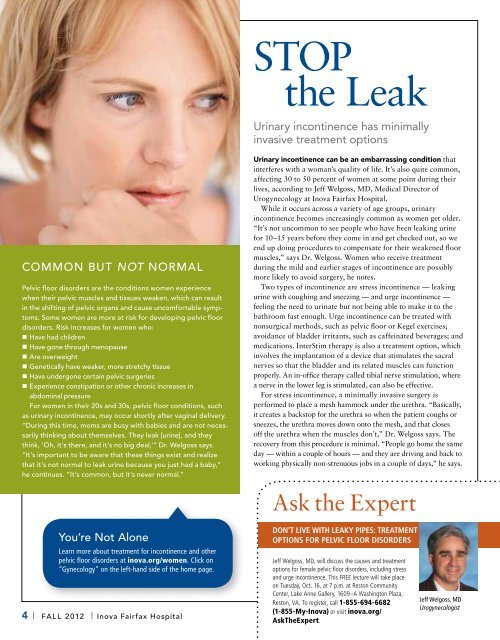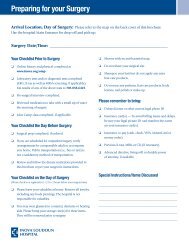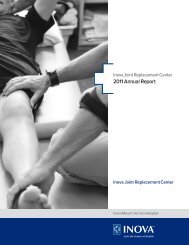m fall 2012 - Inova Health System
m fall 2012 - Inova Health System
m fall 2012 - Inova Health System
You also want an ePaper? Increase the reach of your titles
YUMPU automatically turns print PDFs into web optimized ePapers that Google loves.
STOP<br />
the Leak<br />
Urinary incontinence has minimally<br />
invasive treatment options<br />
Common But Not Normal<br />
Pelvic floor disorders are the conditions women experience<br />
when their pelvic muscles and tissues weaken, which can result<br />
in the shifting of pelvic organs and cause uncomfortable symptoms.<br />
Some women are more at risk for developing pelvic floor<br />
disorders. Risk increases for women who:<br />
Have had children<br />
Have gone through menopause<br />
Are overweight<br />
Genetically have weaker, more stretchy tissue<br />
Have undergone certain pelvic surgeries<br />
Experience constipation or other chronic increases in<br />
abdominal pressure<br />
For women in their 20s and 30s, pelvic floor conditions, such<br />
as urinary incontinence, may occur shortly after vaginal delivery.<br />
“During this time, moms are busy with babies and are not necessarily<br />
thinking about themselves. They leak [urine], and they<br />
think, ‘Oh, it’s there, and it’s no big deal,’” Dr. Welgoss says.<br />
“It’s important to be aware that these things exist and realize<br />
that it’s not normal to leak urine because you just had a baby,”<br />
he continues. “It’s common, but it’s never normal.”<br />
Urinary incontinence can be an embarrassing condition that<br />
interferes with a woman’s quality of life. It’s also quite common,<br />
affecting 30 to 50 percent of women at some point during their<br />
lives, according to Jeff Welgoss, MD, Medical Director of<br />
Urogynecology at <strong>Inova</strong> Fairfax Hospital.<br />
While it occurs across a variety of age groups, urinary<br />
incontinence becomes increasingly common as women get older.<br />
“It’s not uncommon to see people who have been leaking urine<br />
for 10–15 years before they come in and get checked out, so we<br />
end up doing procedures to compensate for their weakened floor<br />
muscles,” says Dr. Welgoss. Women who receive treatment<br />
during the mild and earlier stages of incontinence are possibly<br />
more likely to avoid surgery, he notes.<br />
Two types of incontinence are stress incontinence — leaking<br />
urine with coughing and sneezing — and urge incontinence —<br />
feeling the need to urinate but not being able to make it to the<br />
bathroom fast enough. Urge incontinence can be treated with<br />
nonsurgical methods, such as pelvic floor or Kegel exercises;<br />
avoidance of bladder irritants, such as caffeinated beverages; and<br />
medications. InterStim therapy is also a treatment option, which<br />
involves the implantation of a device that stimulates the sacral<br />
nerves so that the bladder and its related muscles can function<br />
properly. An in-office therapy called tibial nerve stimulation, where<br />
a nerve in the lower leg is stimulated, can also be effective.<br />
For stress incontinence, a minimally invasive surgery is<br />
performed to place a mesh hammock under the urethra. “Basically,<br />
it creates a backstop for the urethra so when the patient coughs or<br />
sneezes, the urethra moves down onto the mesh, and that closes<br />
off the urethra when the muscles don’t,” Dr. Welgoss says. The<br />
recovery from this procedure is minimal. “People go home the same<br />
day — within a couple of hours — and they are driving and back to<br />
working physically non-strenuous jobs in a couple of days,” he says.<br />
Ask the Expert<br />
You’re Not Alone<br />
Learn more about treatment for incontinence and other<br />
pelvic floor disorders at inova.org/women. Click on<br />
“Gynecology” on the left-hand side of the home page.<br />
4 | FALL <strong>2012</strong> | <strong>Inova</strong> Fairfax Hospital<br />
Don’t Live With Leaky Pipes: Treatment<br />
Options for Pelvic Floor Disorders<br />
Jeff Welgoss, MD, will discuss the causes and treatment<br />
options for female pelvic floor disorders, including stress<br />
and urge incontinence. This FREE lecture will take place<br />
on Tuesday, Oct. 16, at 7 p.m. at Reston Community<br />
Center, Lake Anne Gallery, 1609–A Washington Plaza,<br />
Reston, VA. To register, call 1-855-694-6682<br />
(1-855-My-<strong>Inova</strong>) or visit inova.org/<br />
AskTheExpert.<br />
Jeff Welgoss, MD<br />
Urogynecologist

















